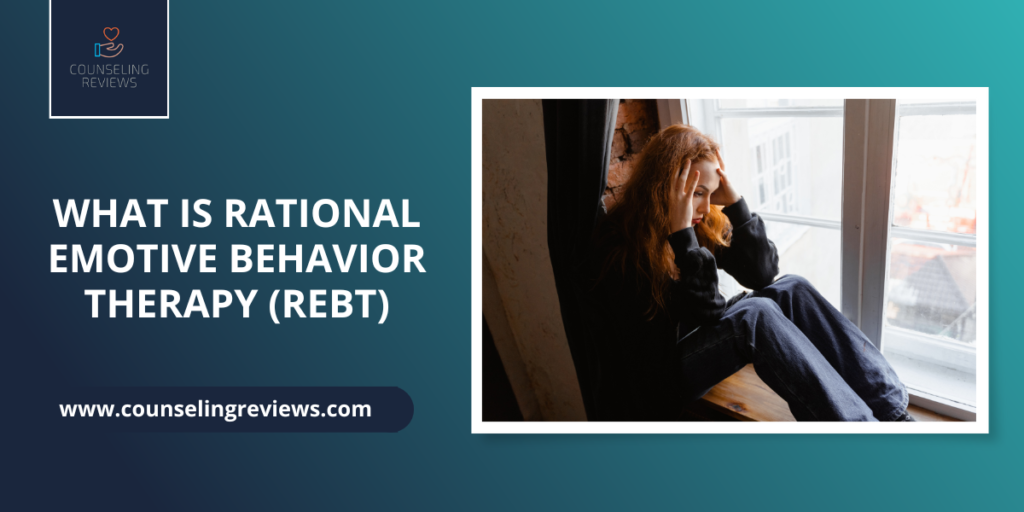Rational Emotive Behavior Therapy (REBT) is a form of psychotherapy that helps people overcome psychological difficulties. Psychotherapy, also known as talk therapy, is a treatment approach to address various mental health and psychological conditions. During a therapy session, a client or patient talks to a licensed mental health professional who uses evidence-based techniques to treat emotional, behavioral, and cognitive problems.
There are different psychotherapies, each backed by various schools of thought. The most prominent psychotherapies are cognitive behavior therapy, psychodynamic therapy, humanistic therapy, and eclectic therapy. A therapist may use one or more of these techniques to help their client overcome various difficulties.

Dr. Albert Ellis, a pioneering psychologist responsible for a paradigm shift in psychotherapeutic interventions, developed REBT in 1955. Unlike other forms of therapy, REBT focuses on the “here and now” or the difficulties that the client may be experiencing in the present.
This article takes a deep look at REBT, its core principles, and its efficacy.
What is REBT?
REBT is a form of cognitive behavior therapy that helps individuals and groups to address irrational thinking patterns and replace them with realistic and helpful thoughts.
Although Albert Ellis developed REBT before Aaron Beck popularized cognitive behavior therapy (CBT), REBT is considered a form of CBT today. Before we understand what REBT is, it is essential to know how it came to be.
A brief history of psychotherapy, until REBT’s nascence
Earlier forms of therapy developed by Sigmund Freud and Carl Jung focused on the “unconscious mind”. However, the concept of the unconscious mind was later challenged by scientific scrutiny. This led to the emergence of behavior therapy, which focused only on the observable behavior.
Much later, Albert Ellis began his work on rational therapy after noticing that much distress is caused due to irrational thoughts. After taking behavior and emotions into account, rational therapy evolved into rational emotive behavior therapy (REBT).
REBT strongly influenced Aaron Beck, often considered the father of cognitive behavior therapy. While Ellis took a more directive and disputation approach toward helping his clients identify negative thought patterns, Beck preferred a more indirect approach.
Aaron Beck’s CBT grew into a powerful force in the field of clinical psychology, while Ellis’ technique eventually came under the umbrella of CBT like other forms of cognitive-oriented therapies such as dialectical behavior therapy (DBT), schema therapy, etc.
REBT is a philosophy of living
Albert Ellis considered his therapeutic approach as a philosophy of living. He believed that more than the triggering events, it is the underlying irrational beliefs that cause emotions and behaviors that are unpleasant. Hence, he thought changing these irrational beliefs would positively affect emotional pain reduction.
The same event can be interpreted differently if you have a different belief, leading to various emotional and behavioral consequences. Hence, REBT focuses on restructuring irrational ideas and thoughts and acting logically.
The “Three Musts” of REBT
Irrational beliefs usually revolve around the “Three Basic Musts.” These three musts can be summarized as follows:
-
“I must be perfect and gain other people’s approval. If I don’t, then I am not good enough”.
This is an inflexible way of thinking that affects almost everyone. It results in placing unrealistic expectations of ourselves and overemphasizing others’ opinions of us. It also results in rejection of self and measuring one’s self-worth by how much one achieves or is popular. In simple terms, this is seeking validation.
When an individual cannot satisfy this “must”, they experience sadness, disappointment, shyness, etc. They may begin to avoid risks or become workaholics.
-
“Others must be perfect. If they are not, they do not deserve anything”.
This irrational belief tends to assume a moral high ground or superiority complex in relation to others. This belief tends to result in black-and-white thinking, which often translates to right or wrong with no scope for gray areas.
It also leads to self-centered behavior and unaccepting of others’ faults. These beliefs cause anger, resentment, and impatience. Some of the behavioral consequences are bullying, aggression, and intolerance.
-
“Life must be easy and without difficulties”.
This inflexible and irrational thought gives a lot of emphasis to a problem-free life. It underestimates a person’s ability to tolerate distress and causes them to resist life’s problems. These beliefs often translate into thoughts such as everything must happen according to me.
Examples include “I must avoid difficulties”, “I should not experience any inconveniences”, etc. The emotional consequences can range from self-pity, depression, and inability to tolerate distress. To escape these distressing emotions, people may engage in substance abuse, procrastination, and overindulgence in sensual pleasures.
What is the ABCDE model of REBT?
The ABCDE model is the approach with which an REBT therapist works with their clients. It consists of the original ABC model, with “DE” being added later on.
-
A – Activating event
-
B – Beliefs
-
C – Consequences (emotional and behavioral)
-
Activating event – This can be described as a triggering event. It triggers you to behave, feel, or think in a specific manner. In the therapeutic context, an activating or triggering event leads to adverse reactions and responses.
-
Belief – A belief is a thought that is assumed to be true, whether evidence exists or not. In REBT, irrational beliefs are activated during certain situations, and lead to irrational thoughts and unrealistic evaluations of the triggering event.
-
Consequence – Emotions and behaviors are a consequence of the irrational thoughts and beliefs that are triggered by the activating event.
Example of how ABC works in action
Activating event: A teacher remarks to the student that he could have performed better in the exam.
Beliefs: This event triggers irrational beliefs and thoughts such as “I am not good at studies,” “I cannot perform well,” “This teacher does not like me,” etc.
Consequences: Consequently, the student experiences unhelpful negative emotions such as sadness, resentment, insecurity, etc. It is important to note that thoughts and emotions lead to behaviors and are a part of the consequence. Someone who strongly believes they cannot perform satisfactorily may feel dejected (unhelpful negative emotion) and stop attempting to do better (unhelpful behavior).
The therapist’s role, in this case, is to help the student recognize their irrational thoughts and beliefs and replace them with more rational ones. They may attribute their low performance to realistic factors such as not being prepared enough, stress, teacher bias, etc (rational belief). This leads to appropriate emotions such as disappointment (helpful negative emotion) with the score in conjunction with a realistic evaluation of the situation.
Such an evaluation may lead to healthy behaviors such as preparing well for the exam, distracting oneself from negative emotions and focusing on self-soothing activities, etc.
Now, we come to the D and E parts of the ABCDE model.
-
D stands for Disputation
-
E stands for Effective Behavior
-
Disputation or challenging irrational beliefs and changing unhelpful behaviors are central to REBT. As discussed previously, the therapist takes on a directive role, challenges the client’s irrational beliefs and thoughts, and gives them an opportunity to interpret triggering events differently. The therapist tries to encourage his/her clients arrive at three critical insights:
-
Beliefs or thoughts about an event cause emotional reactions more than the events themselves.
-
Not addressing these beliefs will result in the persistence of irrationality, and individuals will continue to trust in the “three musts.”
-
Ellis proposed that individuals should not stop at understanding these insights but must continue to challenge and dispute their irrational beliefs. It is a constant process that must continue even after the sessions end.
-
Effective behavior helps clients change maladaptive behaviors and live wholesome lives. The ABC model is sometimes known as the ABCDE model, as it also takes disputation and effective behavior into account. Disputation helps identify irrational beliefs and counter them with helpful and rational thoughts.
Techniques used in REBT
REBT uses certain techniques that effectively improve people’s emotional health. These are:
-
Problem-solving – This technique helps clients to address triggering or activating events and rationally look at them. During this process, they also identify their irrational beliefs and how they may affect how they interpret them.
-
Cognitive restructuring – Cognitions are higher mental processes such as thinking, imagining, remembering, etc. As cognitive processes are central to belief formation, REBT therapists help their clients to restructure their cognitions. Doing so will help the client to react differently when the same triggering event occurs. Unhelpful memories may be reinterpreted in a different light so that alternative ones replace the beliefs created due to these experiences.
-
Coping – Life is not always under our control, and there are times when we go through difficulties that we simply cannot manage. In such situations, REBT therapists help their clients to cope with the problem rather than engage in unhelpful emotions or behaviors. Helpful coping strategies include self-soothing activities, relaxation techniques, deep breathing, etc.
-
Acceptance – There are three kinds of acceptance, all influenced by the “three musts” discussed above.
-
Unconditional self-acceptance – Based on the first “must,” this encourages the client to recognize their flaws and that these flaws do not make them less worthy than others.
-
Unconditional other-acceptance – This addresses the second “must” and urges clients to understand that people may not treat them reasonably always and that there is no reason they should be treated fairly. In addition, if they are not treated fairly, it says nothing about them and their self-worth will not diminish.
-
Unconditional life acceptance – This maxim assumes that life will not always turn out the way we want. There is no reason why life must turn out the way we expect it to. We may experience unpleasant events, but we can always try to make them bearable within our means.
How frequently are Rational Emotive Behavior Therapy sessions held?
REBT sessions may be held weekly once. Sometimes, the therapist may decide to hold bi-weekly sessions in order to adopt a more intensive therapeutic approach.
How long does Rational Emotive Behavior Therapy treatment last?
Clients may need between 10 to 20 sessions in order to see changes in their thinking and behavioral patterns. This depends on each case, and is difficult to predict.
What REBT Can Help With
REBT helps treat depression, anxiety, interpersonal relationships, adjustment problems, substance use, eating disorders, and others. It is also used to help groups improve communication skills, work cohesively in teams, and improve organizational culture.
How effective is REBT?
REBT has been found to be quite effective in treating a range of mental health conditions. Here are some evidence-based studies that prove REBT’s efficacy:
-
David et al conducted a study on 349 patients of the Albert Ellis Institute. The participants received psychotherapy sessions between 2007 and 2016. Outcomes were measured after three sessions and at the end of 20 sessions. The results revealed that the patients noticed significant improvements in their functioning after undergoing REBT. The study helped establish that this form of therapy can also be used in clinical settings.
-
Another study systematically analyzed 84 published articles and found that REBT is an effective psychological intervention. However, the study found certain limitations as well.
-
REBT seems to work really well among athletes and adolescents. For example, a study conducted on American football players found that REBT improved their irrational beliefs and enhanced motivation and self-efficacy. Similarly, another study found that REBT improves performance outcomes in elite Paralympic athletes. It improved self-awareness and emotional control, and the athletes could focus better after treatment. These studies suggest that REBT may be more effective in helping people cope with general life stressors than clinical conditions. People with clinical conditions may find REBT confrontational.
REBT vs. CBT: How are they different?
Several concepts of REBT overlap with those of CBT. However, it is essential to note that despite the similarities, there are many differences. For example, REBT is more philosophical, whereas CBT is more practical. REBT practitioners may come across as confrontational due to using disputation as a technique. CBT practitioners may appear more polite to the client
There is a more significant body of research behind CBT than REBT. However, REBT can be helpful in many situations. It is action-oriented and helps people to manage their emotions, thoughts, and behaviors better. At the end of the day, both REBT and CBT are cognitively-oriented therapies that fall under the broader umbrella of CBT.
Who does not benefit from REBT?
Although REBT is an effective therapy for several psychological conditions and general challenges that people face, it may not be suitable to treat personality disorders, schizophrenia, and other mental health conditions.
In addition, each patient or client is unique and may require tailor-made interventions. This often comes to light during the therapeutic process when clients begin to show signs of resistance.
For example, people who do not like being challenged may benefit from traditional CBT methods. However, it may take a longer time.
Using REBT’s disputation technique on someone who is guarded will derail the rapport that every therapist must try to build. However, a client who is practical and does not wish to arrive at insight on their own with the help of a therapist that employs an indirect approach may prefer REBT due to its directive technique.
What should I look for in an REBT therapist?
Most clinical psychology programs in English-speaking countries such as the US, UK, Australia, Canada, New Zealand, and India are cognitive behaviourally-oriented. As such, they will have at least a certain degree of exposure to REBT techniques. However, many therapists go on to specialize in REBT and tend to offer an intervention that strongly uses REBT techniques.
Before beginning therapy, you can confirm with your therapist which therapeutic modality they are most comfortable with. Please note that if they are CBT-oriented, they may invariably use REBT techniques as they overlap. The major difference is that CBT is less confrontational and may take longer than REBT. In addition, CBT is appropriate for multiple clinical conditions, whereas REBT may work only for specific conditions listed above.
In short, ensure that your REBT therapist is a trained mental health professional with a valid license to offer therapy in your jurisdiction. Depending on your country, this may range from psychiatrists and clinical psychologists to social workers and mental health nurses.
Should you seek an REBT therapist or a more eclectic CBT therapist?
At least in countries like India, it is infrequent to find clinical psychologists who label themselves as “REBT therapists” or “CBT therapists.” Regardless of your difficulties, getting a comprehensive psychological evaluation, including assessments, is essential so that your mental healthcare provider can formulate a case. Then, they can make the right decision regarding which treatment approach is most suitable for them.
Your psychiatrist or clinical psychologist may consult with each other before deciding on a therapeutic modality. While learning about different therapeutic techniques is always good, your treatment provider may choose the best approach depending on your diagnosis. This approach may sometimes change, especially when your therapist feels treatment resistance or progress is not seen.
Hence, if you are facing psychological difficulties, your first step should be to contact a therapist and discuss your problems in detail. The therapeutic approach depends on the unique challenges you may be facing.
REPT FAQs
The main goal of Rational Emotive Behavior Therapy (REBT) is to help individuals identify and change irrational beliefs and thought patterns that lead to emotional distress and self-defeating behaviors. By promoting rational thinking and adaptive behaviors, REBT aims to improve emotional well-being and foster personal growth.
Rational Emotive Behavior Therapy (REBT) uses various cognitive and behavioral techniques to help individuals challenge and change irrational beliefs and thoughts that contribute to emotional distress. Some key techniques include disputing irrational beliefs, employing rational self-talk, behavioral homework assignments, and desensitization to reduce emotional reactivity.
REBT (Rational Emotive Behavior Therapy) can help with various conditions, including anxiety disorders, depression, phobias, obsessive-compulsive disorder (OCD), post-traumatic stress disorder (PTSD), anger issues, low self-esteem, relationship problems, and stress management. It focuses on challenging irrational beliefs and promoting healthier thought patterns to improve emotional well-being and behavior.




